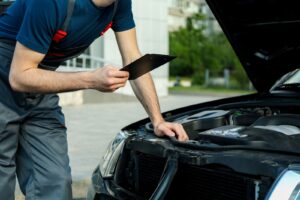Buying a used car can be a smart financial decision, but it requires careful planning and thorough research to ensure you get the best deal. Whether you’re a first-time buyer or looking to replace your current vehicle, understanding the essential steps of purchasing a used car is crucial. From inspecting the car and verifying its service history to negotiating the price and finalizing the purchase, each step plays a vital role in making an informed decision. In this guide, we walk you through the process of buying a used car, providing expert tips and insights to help you navigate the market confidently.
How Can I Guarantee My Pre-Owned Vehicle Is in Good Condition?
CarInspect provides a thorough 170-point inspection conducted by certified mechanics, ensuring every aspect from mechanical functionality to aesthetics is meticulously checked. After a mobile inspection, we send you a detailed digital report within 24 hours, highlighting any potential issues and giving you the opportunity to ask our inspectors questions directly. With our transparent and unbiased approach, backed by a 90-day warranty, you can confidently assess the vehicle’s condition before making a purchase decision
Buying a Pre-Owned Car: A Step-By-Step Process
Step 1: Determine Your Budget
Before checking used cars for sale, it’s essential to determine your budget. Calculate your target price, keeping in mind additional costs like sales tax, insurance, and potential repairs. Knowing your maximum price can help you narrow down your options and avoid financial troubles down the line.
New immigrants to Canada: Getting a car loan (written by an actual immigrant)
Step 2: Research and Select Your Vehicle
Consider what you need from a vehicle. Are you looking for a reliable vehicle for daily commutes, or do you need something with a higher towing capacity for weekend getaways? Factor in the average cost of the type of vehicle you’re interested in and compare it with the average price on various marketplaces.
Step 3: Choose Between a Dealer and a Private Seller
Decide if you want to buy from a dealer or a private seller:
- Dealerships: Dealers typically offer certified pre-owned (CPO) vehicles. These are used cars that meet manufacturer standards for quality and reliability. CPO cars often come with extended warranty coverage, providing buyers with added peace of mind against unforeseen repairs. However, these benefits come at a higher price point compared to non-certified used cars, and some dealerships are not trustworthy (always check for online reviews before buying!)
- Private Sellers: Purchasing from a private seller can potentially offer a better deal financially because there’s typically no dealership markup. However, buying privately requires more caution and diligence. Private-party sales do not include warranties or guarantees beyond what is explicitly agreed upon in the sale contract (unless you inspect the car with CarInspect, you’ll be eligible to private warranties). Buyers need to personally verify the vehicle’s condition and ensure all legal and financial aspects of the transaction are handled correctly.
In essence, buying from a dealership offers assurances in terms of quality and warranty coverage, albeit at a higher cost. Conversely, buying from a private seller may offer cost savings but demands thorough research and due diligence to mitigate risks associated with the transaction.
Step 4: Get Vehicle History and Maintenance Reports
Carfax provides detailed reports on a car’s maintenance history and overall vehicle history, offering a snapshot of the vehicle’s past, including accidents, repairs, and previous ownership details. These reports can help you understand the general condition and background of the vehicle, highlighting any reported issues or major events.
However, they sometimes lack comprehensive information, as not all repairs and incidents are always reported. This is why a pre-purchase inspection (PPI) is invaluable. A thorough PPI enables you to verify if the repairs were done correctly, uncover any defects that might have been covered up, and confirm that the vehicle hasn’t been involved in any undisclosed accidents.
Order your Carfax vehicle history report
Step 5: Perform a Pre-Purchase Inspection
A proper inspection is non-negotiable. It’s important to have a trusted mechanic conduct a pre-purchase inspection to check for structural damage, necessary mechanical repairs, and common issues. CarInspect provides you with a detailed 170-point report that covers mechanical, functional, aesthetics, road test, potential repairs, and the inspector’s feedback.
Book a pre-purchase car inspection
Step 6: Negotiate a Deal
Use the information gathered from your research and inspection to negotiate a fair deal. Be prepared to discuss the market price, vehicle condition, and any issues that need addressing. Knowing the fair price for the car can help you negotiate effectively.
Step 7: Consider All Costs
Beyond the purchase price, consider the cost of ownership, including insurance, maintenance, and repair costs. Check with your insurance company for quotes and ensure you have proof of insurance before driving away.
Step 8: Complete the Paperwork
Ensure all paperwork is in order. For private-party sales, verify the title transfer and odometer disclosure. Dealers will handle most of this but double-check for accuracy. Keep copies of the sales contract, service records, and any warranties provided.
Step 9: After the Purchase: Ongoing Maintenance and Insurance
Remember to keep comprehensive records of all maintenance and repairs. Regularly check for any recalls or updates from the manufacturer to ensure your vehicle remains safe and reliable.
10 Tips to Simplify the Second-Hand Car Buying Process
Navigating the used-car market can be daunting, but with the right approach, you can simplify the process and secure a reliable vehicle. Here are some essential tips to help streamline your second-hand car purchase:
- Research Online Marketplaces: Start your search on reputable online marketplaces where you can browse a wide range of vehicles. Pay attention to listings from verified sellers to ensure credibility.
- Verify Vehicle Identification: Always check the Vehicle Identification Number (VIN) on the car and compare it with the information provided in the vehicle registration documents. This helps confirm the car’s identity and history.
- Understand the Vehicle’s History: Obtain a detailed accident history report from services like Carfax to check for any past collisions or significant repairs. This will give you insights into the car’s past and any potential issues.
- Inspect the Vehicle in Person: Arrange to meet the current owner and inspect the car in person. This allows you to evaluate the car’s condition, check for hidden damage, and assess if it matches the description in the listing. However, if you can’t be there, use the CarInspect service, and an inspector will visit you and report back.
- Check License Plates and Proof of Ownership: Ensure the license plates match the vehicle registration, and the seller provides proof of ownership. This helps verify that the seller has the legal right to sell the car.
- Consider Private Sales Carefully: While private sales can offer better prices, they come with higher risks. Make sure to meet in a safe location and perform thorough checks on the vehicle and the seller (make sure you meet the actual seller).
- Consult an Independent Mechanic: Hire an independent mechanic to conduct a pre-purchase inspection. This will help uncover any hidden mechanical issues and provide an objective assessment of the car’s condition.
- Evaluate Safety Features: Check that all safety features, such as airbags, brakes, and seat belts, are functioning correctly. A vehicle with up-to-date safety features ensures better protection on the road (and less repair costs!).
- Negotiate Wisely: Use the information gathered from the vehicle’s history and mechanical inspection to negotiate a fair price. Be prepared to walk away if the deal doesn’t meet your expectations.
- Finalize the Sale Legally: Ensure all paperwork is completed accurately, including transferring the vehicle registration and obtaining a bill of sale. This helps avoid any legal complications in the future.
By following these tips, you can simplify the second-hand car buying process, ensuring a smoother and more secure purchase.
Ensuring Safe Private-Party Purchases: How to Avoid a Scam
Avoiding a shady seller when buying a used vehicle involves several considerations to protect yourself from scams or misrepresented vehicles:
Know Your Rights and Protections
- Consumer Reports: Look up reviews to learn about common issues with the car model.
- Consumer Protection Laws: Understand your legal rights when buying a car, especially regarding refunds and disclosures.
- Avoid Rushed Deals: Shady sellers may pressure you to make quick decisions or avoid answering questions.
Financing and Price Negotiation
- Loan Rates: Compare rates from different lenders to find the best financing option.
- Negotiate Fairly: Research the car’s value and negotiate based on its condition and market price.
- Confirm Transaction Details: Make sure the final price matches what you agreed upon, including all terms.
Pre Purchase Inspection
- Get an Inspection: Have a professional inspect the car before buying to uncover hidden problems.
- Identify Issues: Inspectors can find mechanical issues, accident damage, or undisclosed repairs.
- Make Informed Decisions: Use the inspection report to decide if the car is worth buying or if you should walk away.
How to Maximize the Life of Your Newly Bought Pre-Owned Vehicle
Purchasing a used car is a significant investment, and ensuring its longevity is crucial. To help you maximize the life of your newly bought used car, consider these tips:
Maintenance is Key
Keep Up with Regular Maintenance
Maintaining your car’s health starts with regular servicing. Adhere to the manufacturer’s recommended maintenance schedule, which typically includes oil changes, tire rotations, brake inspections, and fluid checks. This not only enhances performance but also extends the vehicle’s life.
Track Maintenance Records
Documenting every service, repair, and inspection helps track the vehicle’s history and ensures you’re not missing any crucial upkeep. This record can also be valuable if you decide to sell the car in the future.
Monitor Fluids and Tire Pressure
Regularly check your car’s fluids, including oil, coolant, brake fluid, and transmission fluid. Maintaining the correct fluid levels prevents engine damage and other mechanical issues. Additionally, ensure your tires are properly inflated to avoid premature wear and improve fuel efficiency.
Drive Smart and Safe
Practice Good Driving Habits
How you drive significantly impacts your car’s longevity. Avoid harsh acceleration, sudden braking, and overloading the vehicle. Driving smoothly reduces wear and tear on your car’s components.
Address Issues Promptly
Never ignore warning signs like the check engine light. Addressing problems early can prevent minor issues from turning into costly repairs. If you notice any unusual sounds, smells, or performance changes, have your car checked immediately.
Financial Considerations
Understand Your Insurance Policy
Ensure you have the right insurance coverage for your vehicle. Shop around for the best rates and consider bundling policies with your auto insurance company for discounts. Adequate insurance protects you from significant financial loss in case of accidents or theft.
Manage Your Auto Loan
If you financed your vehicle purchase, keep up with your monthly payments to avoid penalties and protect your credit score. Consider refinancing your auto loan if better rates become available, which can lower your monthly payment target and overall costs.
Additional Tips
Use Quality Parts
When replacing parts, opt for high-quality or OEM (original equipment manufacturer) parts. Cheap, low-quality parts might save money upfront but can lead to more significant issues and higher maintenance costs down the line.
Avoid Short-Term Warranties
Be cautious with short-term warranties or service contracts that might not cover significant repairs. Evaluate warranty options carefully to choose a plan that offers comprehensive coverage and peace of mind.
Protect Your Car’s Exterior and Interior
Regularly wash and wax your car to protect its paint from environmental damage. Keep the interior clean and condition the seats to prevent wear. Protecting both the exterior and interior enhances your vehicle’s appearance and resale value.
Use the Car Regularly
Regular use prevents mechanical issues that can arise from long periods of inactivity. However, avoid excessive short trips that don’t allow the engine to reach optimal operating temperature, which can lead to increased wear.
Buy the Ideal Pre-Owned Vehicle Hassle-Free with CarInspect
CarInspect ensures your car-buying experience is stress-free and informed. Our certified mechanics provide comprehensive 170-point reports within 24 hours, guiding you through the entire process from booking to negotiation. Our inspections start at $189, including a 90-day warranty for added assurance.
We’re available all across Canada:
Don’t settle for uncertainty when buying a used car—partner with CarInspect and buy with confidence!











